
This article was written by Aisling Pigott, Jennifer Scheib, and Kyri Baker.
Hot summer days can mean high electricity bills. People want to stay comfortable without wasting energy and money. Maybe your household has fought over the best strategy for cooling your space. Which is more efficient: running the air conditioning all summer long without break, or turning it off during the day when you’re not there to enjoy it?
We are a team of architectural and building systems engineers who used energy models that simulate heat transfer and A/C system performance to tackle this perennial question: Will you need to remove more heat from your home by continuously removing heat throughout the day or removing excess heat only at the end of the day?
The answer boils down to how energy intensive it is to remove heat from your home. It’s influenced by many factors such as how well your house is insulated, the size and type of your air conditioner and outdoor temperature and humidity.
According to our unpublished calculations, letting your home heat up while you’re out at work and cooling it when you get home can use less energy than keeping it consistently cool—but it depends.
Blast A/C all day, even when you’re away?
First, think about how heat accumulates in the first place. It flows into your home when the building has less stored heat than outside. If the amount of heat flowing into your home is given by a rate of “1 unit per hour,” your A/C will always have 1 unit of heat to remove every hour. If you turn off your A/C and let the heat accumulate, you could have up to eight hours’ worth of heat at the end of the day.
It’s often less than that, though. There is a limit to how much heat a house can store. And the amount of heat that enters your home depends on how hot the building was to begin with. For example, if your home can only store 5 units of thermal energy before coming to an equilibrium with the outdoor air temperature, then at the end of the day you will only have to remove 5 units of heat at most.
Additionally, as your home heats up, the process of heat transfer slows down; eventually it reaches zero heat transfer at equilibrium, when the temperature inside is the same as the temperature outside. Your A/C also cools less effectively in extreme heat, so keeping it off during the hottest parts of the day can increase overall efficiency of the system. These effects mean there’s no one straightforward answer to whether you should blast the A/C all day or wait until you get back home in the evening.
Energy used by different A/C strategies
Consider a test case of a small home with typical insulation in two warm climates: dry (Arizona) and humid (Georgia). Using energy modeling software created by the U.S. National Renewable Energy Laboratory for analyzing energy use in residential buildings, we looked at multiple test cases for energy use in this hypothetical 1,200 square-foot (110 square-meter) home.
We considered three temperature strategy scenarios. One has the indoor temperature set to a constant 76° Fahrenheit (24.4° Celsius). A second lets the temperature float up to 89° F (31.6°C) during an eight-hour workday—a “setback.” The last uses a temperature setback to 89° F (31.6° C) for a short four-hour workday.
Within these three scenarios, we looked at three different A/C technologies: a single stage central A/C, a central air source heat pump (ASHP) and minisplit heat pump units. Central A/C units are typical of current residential buildings, while heat pumps are gaining popularity due to their improved efficiency. Central ASHPs are easily used in one-to-one replacements of central A/C units; minisplits are more efficient than central A/C but costly to set up.
We wanted to see how energy use from A/C varied across these cases. We knew that regardless of the HVAC technology used, the A/C system would surge when the thermostat setpoint returned to 76° F (24.4° C) and also for all three cases in the late afternoon when outdoor air temperatures are usually the highest. In the setback cases, we programmed the A/C to start cooling the space before the resident is back, ensuring thermal comfort by the time they get home.
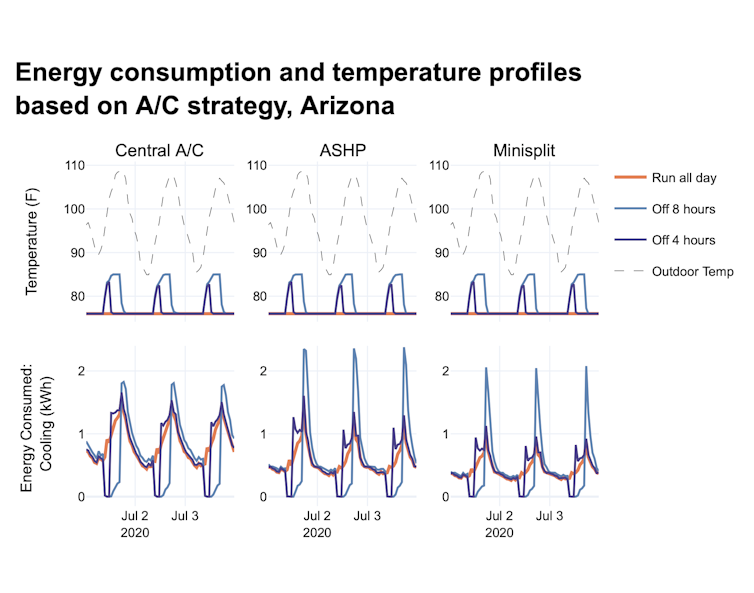
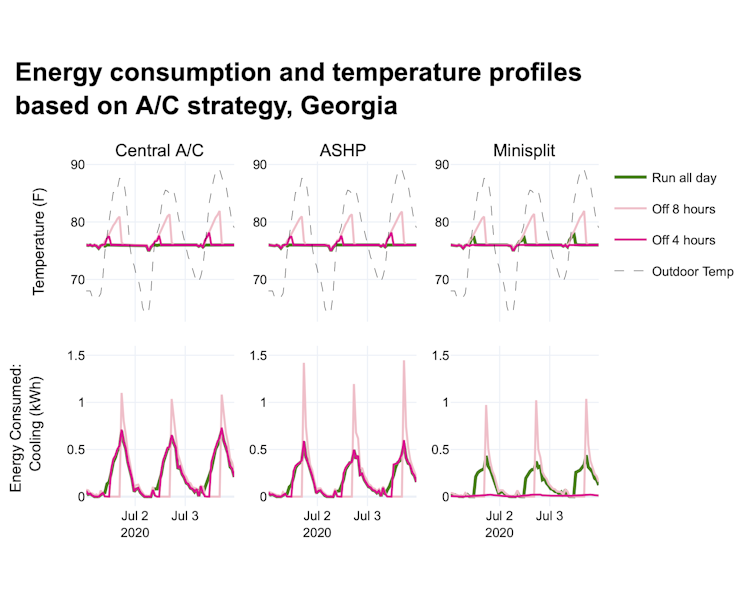
What we found was that even when the A/C temporarily spikes to recover from the higher indoor temperatures, the overall energy consumption in the setback cases is still less than when maintaining a constant temperature throughout the day. On an annual scale with a conventional central A/C, this could result in energy savings of up to 11%.
However, the energy savings may decrease if the home is better insulated, the A/C is more efficient or the climate has less dramatic temperature swings.
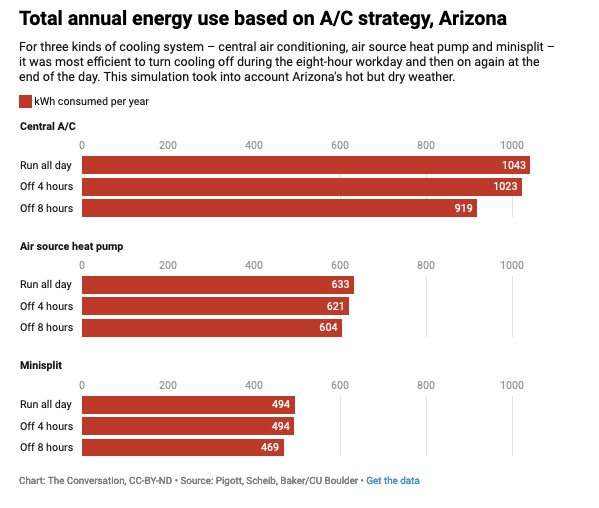
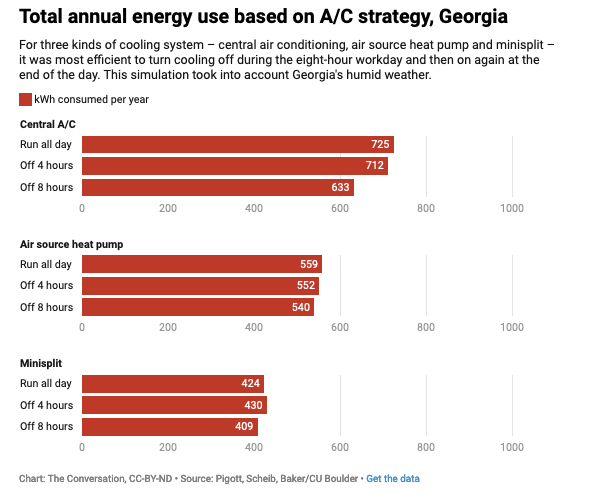
The central air source heat pump and minisplit heat pump are more efficient overall but yield less savings from temperature setbacks. An eight-hour setback on weekdays provides savings regardless of the system type, while the benefits gleaned from a four-hour setback are less straightforward.
All three authors are affiliated with the University of Colorado Boulder. Aisling Pigott is a PhD student in architectural engineering. Jennifer Schweib is an assistant teaching professor of building systems engineering. Kyri Baker is an assistant professor of building systems engineering. This article originally appeared at The Conversation.
Weekly Newsletter
Get building science and energy efficiency advice, plus special offers, in your inbox.






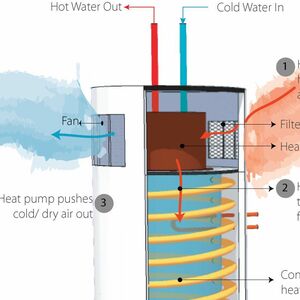
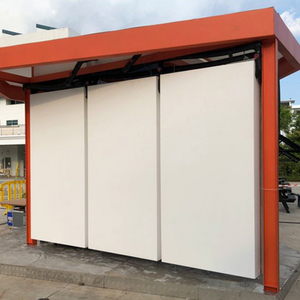






7 Comments
What, exactly, is the difference between "Central A/C" and "central air source heat pump" in this context?
Obviously, an air conditioning unit is a heat pump and always has been... but yes, by convention we're only referring to them as "heat pumps" if they have the reversing valve and thus the unit can be used to heat a space in addition to cooling it. It would make sense, then, that a "Central A/C" simply cools while the "central air source heat pump" both cools and heats.
But... this research exclusively focused on cooling and so the ability to heat seems irrelevant. Why, then, is the ASHP so much more efficient when it's fundamentally the same thing? Is this as simple as "Central A/C" units are older and ASHPs are newer?
At its core, are all three just approximations of specific SEER ratings?
Agreed, these system classifications are extremely confusing, misleading and need to be fixed before publishing!
“Within these three scenarios, we looked at three different A/C technologies: a single stage central A/C, a central air source heat pump (ASHP) and minisplit heat pump units. Central A/C units are typical of current residential buildings, while heat pumps are gaining popularity due to their improved efficiency. Central ASHPs are easily used in one-to-one replacements of central A/C units; minisplits are more efficient than central A/C but costly to set up.”
I’m not sure any part of this paragraph is true without tons of caveats. A single stage AC is not less efficient than the same model single stage HP at cooling. A “mini split” must mean ductless because a ducted minisplit is an easy one to one replacement too. Ductless mini splits can be more expensive than central or not, more efficient or not. They need an expert editor here.
I would break the control strategies down by ASHREA zone then separate out latent vs. sensible loads. For instance in some climates an isothermal dehumidifier could be very efficient.
Is your system big enough to pull the temp down in a reasonable time frame?
If you are at a point where you are near your design temp and you have right sized your equipment it may take a long time to get to setpoint
dehumidification
It takes time to dehumidify the air, and you won't be comfortable until you do
This is the difference between setting back a heating system and an ac system, in my view.
When you are not near design temps, minisplits don't use much energy
I cannot understand what you are talking about! I have been a loyal reader of GBA for years and this might be the dumbest article I have ever read! What is the difference between a central A/c and a heat pump? Nothing that I know of. No mention of moisture and humidity. No mention of multi stage Dc driven inverters. All based on some modeling software, cmon!
I agree with the other commenters. The system ratings and stages are needed to understand these results, e.g. listing the SEER. Also that the specific minisplit discussed is ductless with a variable speed compressor.
If this was the case, the conclusion would be higher SEER means more efficient. An obvious statement.
Instead, it would be beneficial to homeowners to let them know that regardless of their system, scheduling the thermostat saves energy over leaving the set point alone. The amount of savings and scheduling strategy is dependent on the system.
The general scheduling strategy is to keep the system in the most efficient stage, and off when no air conditioning is needed. A typical homeowner might not know what to schedule. A helpful guide by system type should be useful if there is a follow up article.
Is this an Artificial Intelligence article gone bad?
Is an central a/c and a heat pump not the same?
Log in or create an account to post a comment.
Sign up Log in